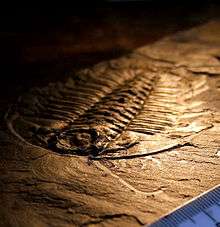Poleta Formation
The Poleta Formation is a geological unit known for the exceptional fossil preservation in the Indian Springs Lagerstätte, located in eastern California and Nevada.[3]
| Poleta Formation Stratigraphic range: Cambrian Series 2 ~519–518 Ma | |
|---|---|
| Underlies | Harkless Formation[1] |
| Overlies | Campito Formation[2] |
| Lithology | |
| Primary | Fine siliciclastics |
| Location | |
| Location | Western Nevada and Eastern California, USA |
| Part of a series on |
| The Cambrian explosion |
|---|
 |
|
Fossil localities |
|
Evolutionary concepts |
Occurrence
The formation dates to the Stage 3 of the yet-to-be-ratified Cambrian Series 2; the lower portion base of the formation and the youngest Lagerstätte beds date to the Nevadella trilobite zone (= Laurentian Montezuman stage), with higher beds dating to the Olenellus trilobite zone (= Laurentian Dyeran stage), making the formation the same age as the Sirius Passet and just younger than the Chengjiang.[3] It outcrops in Esmeralda County in western Nevada.[3]
Depositional setting
The formation was deposited on an offshore shelf, and experienced storm-related pulses of siliciclastic sediment input.[3] Like many other Burgess Shale-type Lagerstätten, this unit was deposited on the Cordilleran margin of the Laurentian continent; it is among the oldest of the Lagerstätten from this region.[3]
Taphonomy
The fossil preservation is markedly similar to that in Utah Lagerstätten, particularly the Spence Shale.[3] The quality of preservation was obtained by the rapid burial of organisms in obrution events, which buried them out of reach of would-be scavengers.[3]
Fauna
Most of the fauna is biomineralized, including brachiopods, hyolithids, trilobites, archeocyathids,[4] and helicoplacoids, which are often articulated.[3] Non-mineralized components of these fossils are also preserved, as are sponges, anomalocaridid parts, and a range of algae and cyanobacteria.[3]
Trace fossils, mainly Planolites, are also common; ichnofossils generally lie on the bedding plane and very few penetrate more than 1 millimetre (0.039 in) into the sediment.[3]
References
- Edwin H. McKee (1968), "Geology of the Magruder Mountain area, Nevada-California" (PDF), U.S. Geological Survey Bulletin: H10, doi:10.3133/B1251H, Wikidata Q57805921
- Edwin H. McKee (1968), "Geology of the Magruder Mountain area, Nevada-California" (PDF), U.S. Geological Survey Bulletin: H7, doi:10.3133/B1251H, Wikidata Q57805921
- English, Adam M.; Babcock, Loren E. (2010). "Census of the Indian Springs Lagerstätte, Poleta Formation (Cambrian), western Nevada, USA". Palaeogeography, Palaeoclimatology, Palaeoecology. 295 (1–2): 236. doi:10.1016/j.palaeo.2010.05.041.
- McKee, E. H.; Gangloff, R. A. (1969). "Stratigraphic Distribution of Archaeocyathids in the Silver Peak Range and the White and Inyo Mountains, Western Nevada and Eastern California". Journal of Paleontology. 43 (3): 716–726. JSTOR 1302466.
